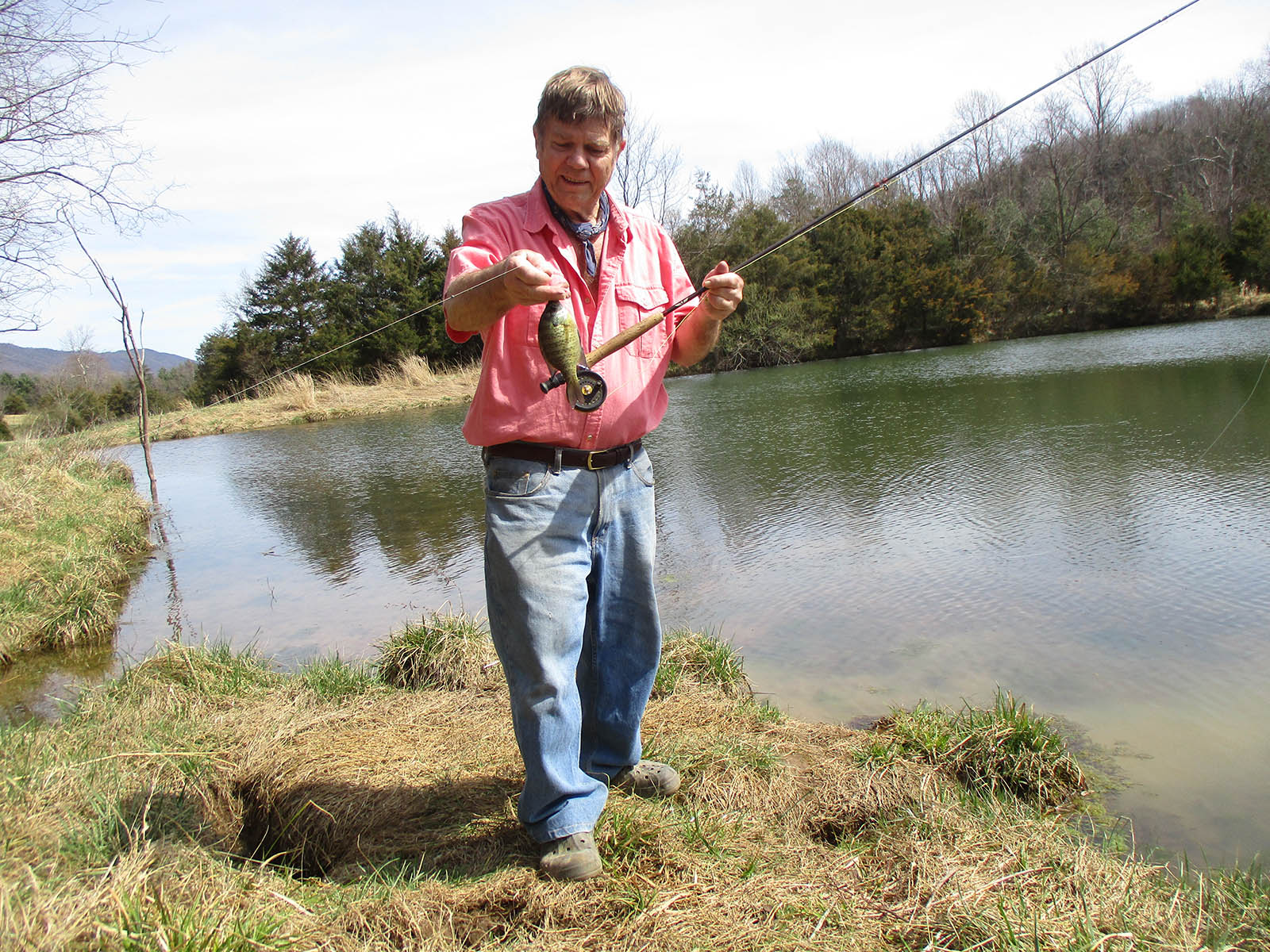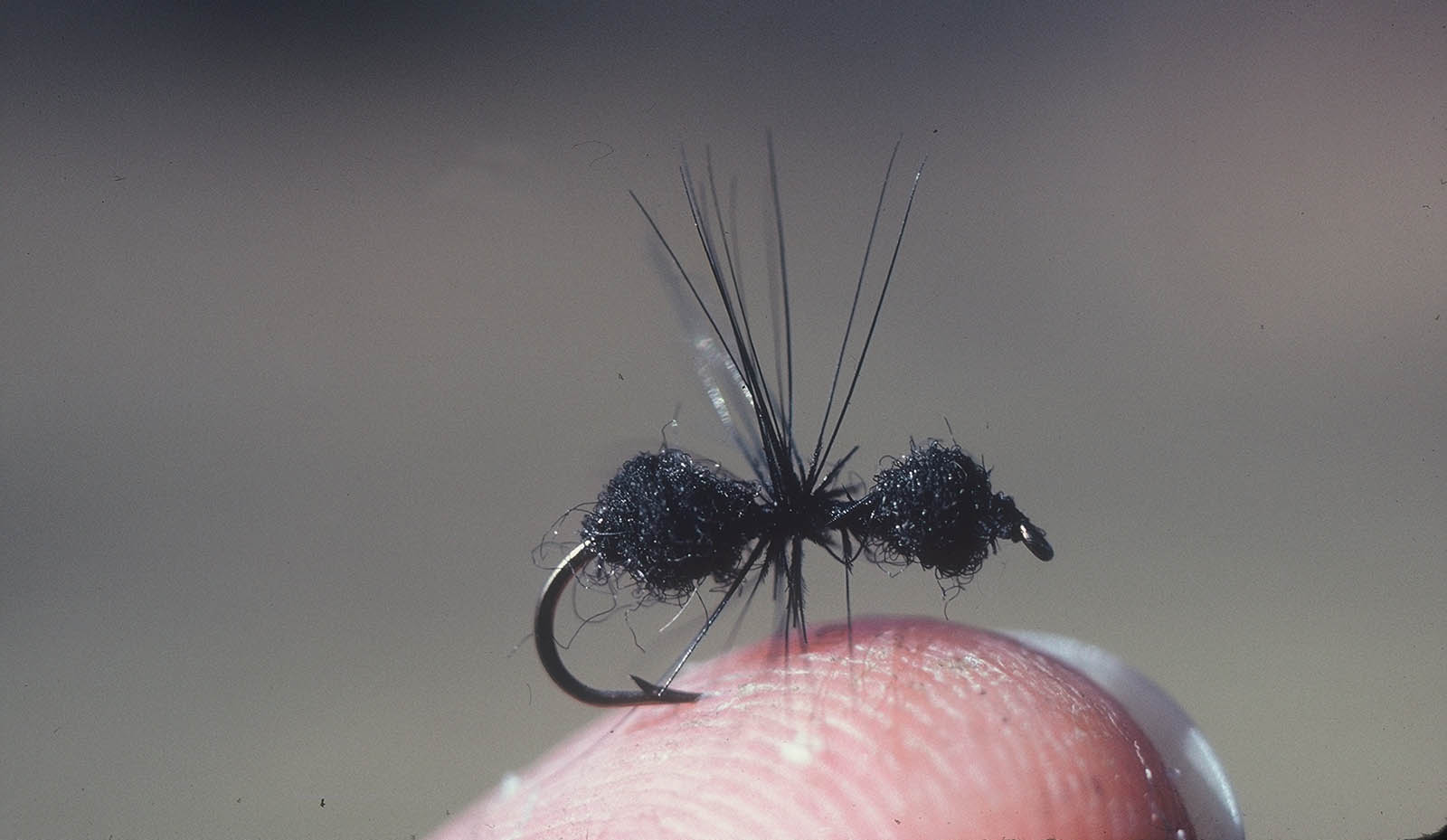By Gerald Almy
Photos by Gerald Almy
When redbuds bloom on shoreline hills and gobblers call from mountain ridges, there’s no more rewarding fish to go after in Virginia than panfish.
Which “panfish?” Take your pick. Members of this clan can include as wide a variety of gamefish as you want. For most anglers, the term “panfish” includes bluegills, redear sunfish (shellcrackers), crappies, redbreasts, rockbass, and fliers. (You can throw in white perch, white bass, and yellow perch, too, if you care to.) Whichever members of this group you plan to focus on, one of the most rewarding ways to go after them is with flyfishing tackle.
If you are a recent convert to fly fishing, these fish are particularly appealing. The reason is that most panfish species are “forgiving” quarries. If you botch a cast or drop the line onto the water clumsily, panfish won’t scurry for cover like a native trout would or go off their feed like a fussy bass.
Panfish have a lot of other appealing qualities that make them great quarries for a spring or summer fly fishing expedition. For starters, they are prolific breeders and usually quite abundant. It often actually helps their populations to harvest a few of the fish you catch. They also inhabit a wide variety of waters, from farm ponds to sprawling lakes, tiny creeks to broad, sweeping rivers.
A recent outing for two lifelong fly fishermen highlighted some of the attractions of angling for this group of fish with flies.
Bluegills as big as a saucer were amassed by the dozens in a weedy cove, clearly visible through the transparent water. They hung nearly motionless over spawning depressions fanned out in the sandy lake bottom. The only sign of life—dozens of gently rotating pectoral fins.
It was a marvelous sight, and soon the two anglers were false casting, then dropping sponge rubber spiders near the mass of fish. In seconds they were rewarded by the sweet sound of bluegills gently sucking in their topwater bugs. Rods bent tight, and minutes later they were both lifting in fat, colorful panfish. Before they left the cove, over 30 sassy bluegills had been landed, with a dozen kept on ice for later meals, the rest released unharmed.

It’s hard to think of a greater angling pleasure than casting surface flies to a huge school of eager-to-bite panfish. The action starts out strong in spring and extends right through fall. A variety of cooperative sunfish are available within minutes or at most an hour’s drive of every Virginia angler.
And you don’t need any elaborate or expensive equipment to break into this sport. A $100-150 outfit will get you started, and only a small selection of flies and ancillary gear is required.
Late spring through early summer is a particularly appealing time to fly fish for bluegills and other panfish because the fish are in shallow water then. Sometimes you can even see them, hovering over their beds or next to weeds and brush. Good fishing begins as soon as waters warm into the 50s, with even more consistent sport as it reaches the 60s and 70s.
Mating season for bluegills is heaviest around the new or full moon. Visually search shoreline areas at these times until you pinpoint spawning fish. If you can’t see the quarry, probe likely fish-holding cover.
If you are going after crappies, focus on coves with flooded brush piles and docks where the fish like to hang out. For rockbass and redbreasts, probes eddies and backwaters in rivers and the middle of deep slow pools.
Backwater bays and coves are particularly good bets for bluegills, and hard bottom is favored for spawning, such as sand, clay or small gravel. Muddy bottoms are used as a last resort. A tactic some pan fishermen use is to probe the bottom with a long stick, searching for a bottom that’s harder than the surrounding lake floor.
Often with the aid of polarizing sunglasses and a hat you can see the quarry hovering in the water, typically in depths of 1 to 6 feet. You might also see the beds—scoured out areas about 12-18 inches across that the males dig out and females deposit eggs in.
Tip: You can sometimes even smell these spawning panfish. They give off a sweet smell like ripe melons. If you can’t pinpoint fish visually or with your nose, probe weed beds, points, blowdowns, brush piles, planted fish structures, and docks.
Tackle & Flies
Tackle need not be elaborate. Go with a rod of 8 to 9 feet, balanced with a 4 to 7 weight forward or bass bug floating line. Add a tapered leader of 7 to 10 feet with a tippet testing 3 to 5 pounds and you’re set to go. Flies for spawning panfish come in many varieties, but be sure whatever types you choose that they have small hooks. Sizes 6 through 12 are perfect.
Cork poppers are good for bluegills, rockbass, and other sunfish if they are in an aggressive mood. Occasionally these flies will also work for crappies late in the day when the fish are feeding on schools of minnows near the surface.
As a rule, however, compact streamers such as the Zonker or Clouser Minnow are best for crappies. Work these back at depths of 4 to 6 feet with a hand-twist retrieve to draw strikes from those silver and black panfish.
A floating sponge rubber spider is the fly to use for bluegills and redear sunfish when they are in shallow water. These flies have white rubber band type legs that dangle out the sides and flutter temptingly when you twitch the rod lightly. Since the bugs are soft, fish tend to hold them longer, allowing easy hook-setting.
Another good option for surface fishing is to use regular trout flies. Patterns that work well include the Humpy, Royal Wulff, Irresistible, Adams and Elk Hair Caddis. Flies that imitate terrestrials (insects born on land), are also excellent for bluegills, shellcrackers, rockbass, and redbreasts. Punch out cricket, grasshopper, beetle, and ant patterns with a slight splat. That plopping noise alerts them that a bug and potential dinner might have fallen in from shore.

This black ant pattern can be effective in the summer months when targeting panfish near the shoreline.
After the surface fly lands, let it rest as long as you can stand it. The longer the better. Often strikes will come before you move the fly at all. If there are no takers, twitch the bug once, wait, and then twitch again. After that, cast to a new area or over spotted spawning beds.
If fish tire of taking surface offerings, switch to either a wet fly or a sponge spider with a split shot crimped on the leader 12 to 18 inches above the fly. Effective patterns include the Hare’s Ear nymph, Bitch Creek, Zug Bug, Black Gnat, Black Ant, and small Woolly Worms or Woolly Buggers. Work these with a slow, hand-twist retrieve. When you feel a tug on the line, set the hook quickly!
A half-pound panfish won’t strip line from the reel like a streaking striper or leap like an acrobatic largemouth, but for rewarding sport close to home, or for introducing a newcomer to fly fishing, these pint-sized gamefish are hard to beat!
And be sure to take a few home for dinner. And when you sink your fork into a tender filet fresh from the skillet, you’ll know why they’re called “pan” fish. Scrumptious!


